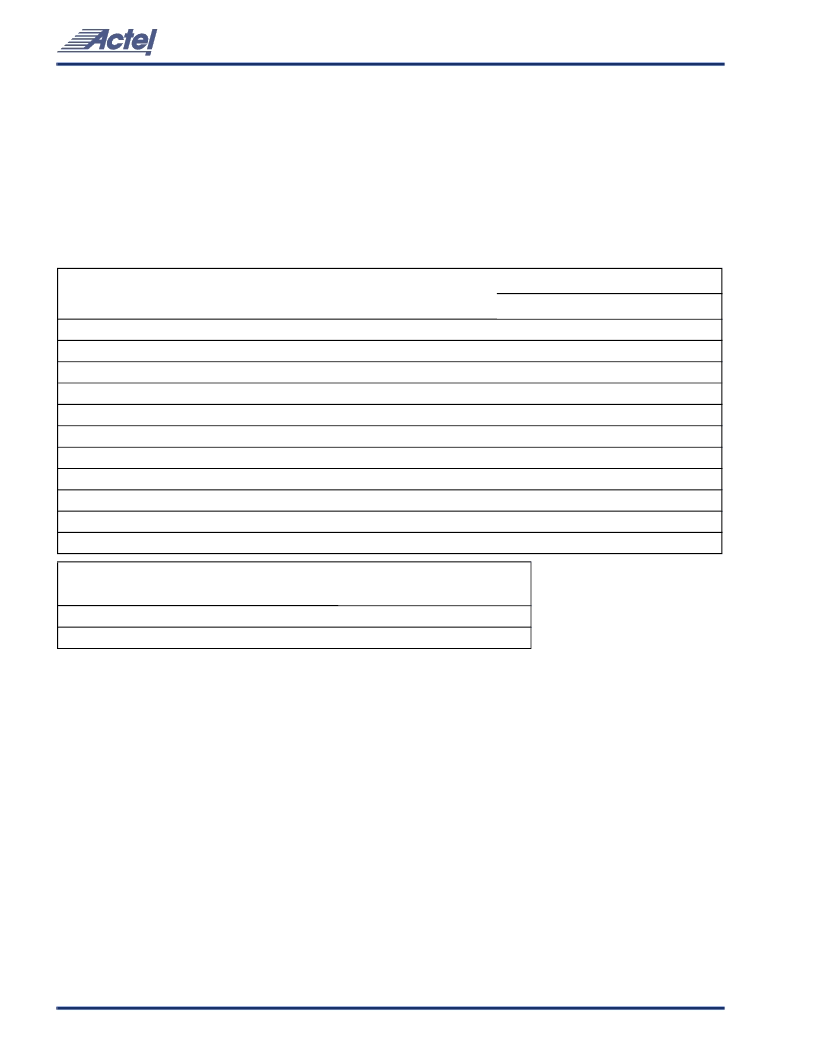- 您現(xiàn)在的位置:買賣IC網(wǎng) > PDF目錄362022 > A42MX09-FTQ176M Field Programmable Gate Array (FPGA) PDF資料下載
參數(shù)資料
| 型號: | A42MX09-FTQ176M |
| 英文描述: | Field Programmable Gate Array (FPGA) |
| 中文描述: | 現(xiàn)場可編程門陣列(FPGA) |
| 文件頁數(shù): | 18/116頁 |
| 文件大?。?/td> | 3110K |
| 代理商: | A42MX09-FTQ176M |
第1頁第2頁第3頁第4頁第5頁第6頁第7頁第8頁第9頁第10頁第11頁第12頁第13頁第14頁第15頁第16頁第17頁當前第18頁第19頁第20頁第21頁第22頁第23頁第24頁第25頁第26頁第27頁第28頁第29頁第30頁第31頁第32頁第33頁第34頁第35頁第36頁第37頁第38頁第39頁第40頁第41頁第42頁第43頁第44頁第45頁第46頁第47頁第48頁第49頁第50頁第51頁第52頁第53頁第54頁第55頁第56頁第57頁第58頁第59頁第60頁第61頁第62頁第63頁第64頁第65頁第66頁第67頁第68頁第69頁第70頁第71頁第72頁第73頁第74頁第75頁第76頁第77頁第78頁第79頁第80頁第81頁第82頁第83頁第84頁第85頁第86頁第87頁第88頁第89頁第90頁第91頁第92頁第93頁第94頁第95頁第96頁第97頁第98頁第99頁第100頁第101頁第102頁第103頁第104頁第105頁第106頁第107頁第108頁第109頁第110頁第111頁第112頁第113頁第114頁第115頁第116頁

40MX and 42MX FPGA Families
18
v5.0
Package Thermal Characteristics
The device junction-to-case thermal characteristic is
θ
jc
,
and the junction-to-ambient air characteristic is
θ
ja
. The
thermal characteristics for
θ
ja
are shown with two different
air flow rates. Ambient temperature (T
A
) is used for
commercial and industrial; case temperature (T
C
) is used
for military.
Maximum junction temperature is 150
°
C.
A sample calculation of the absolute maximum power
dissipation allowed for a PQFP 160-pin package at
commercial temperature is as follows:
Power Dissipation
General Power Equation
P = [I
CC
standby + I
CC
active] * V
CCI
+ I
OL
* V
OL
* N
+ I
OH
* (V
CCI
–
V
OH
) * M
where:
I
CC
standby is the current flowing when no inputs or
outputs are changing.
I
CC
active is the current flowing due to CMOS switching.
I
OL
, I
OH
are TTL sink/source currents.
V
OL
, V
OH
are TTL level output voltages.
N equals the number of outputs driving TTL loads to V
OL
.
M equals the number of outputs driving TTL loads to V
OH
.
Accurate values for N and M are difficult to determine
because they depend on the family type, on design details,
and on the system I/O. The power can be divided into two
components: static and active.
Static Power Component
Actel FPGAs have small static power components that
result in power dissipation lower than PALs or CPLDs. By
integrating multiple PALs/CPLDs into one FPGA, an even
greater reduction in board-level power dissipation can
be achieved.
The power due to standby current is typically a small
component of the overall power. Standby power is
calculated for commercial, worst-case conditions:
I
CC
V
CCA
2 mA
5.25 V
The static power dissipation by TTL loads depends on the
number of outputs driving HIGH or LOW, and on the DC load
current. Again, this number is typically small. For instance,
a 32-bit bus sinking 4 mA at 0.33V will generate 42 mW with
all outputs driving LOW, and 140 mW with all outputs driving
HIGH. The actual dissipation will average somewhere in
between, as I/Os switch states with time.
Power
10.5 mW
Plastic Packages
Pin Count
θ
jc
θ
ja
Still Air
300 ft/min
Plastic Quad Flat Pack
100
12
34
°
C/W
31
°
C/W
Plastic Quad Flat Pack
160
10
32
°
C/W
24
°
C/W
Plastic Quad Flat Pack
208
8
30
°
C/W
23
°
C/W
Plastic Quad Flat Pack
240
3.5
19
°
C/W
16
°
C/W
Plastic Leaded Chip Carrier
44
16
43
°
C/W
31
°
C/W
Plastic Leaded Chip Carrier
68
13
36
°
C/W
25
°
C/W
Plastic Leaded Chip Carrier
84
12
32
°
C/W
22
°
C/W
Thin Plastic Quad Flat Pack
176
11
28
°
C/W
21
°
C/W
Very Thin Plastic Quad Flat Pack
80
12
39
°
C/W
33
°
C/W
Very Thin Plastic Quad Flat Pack
100
10
38
°
C/W
32
°
C/W
Plastic Ball Grid Array
272
3
20
°
C/W
14.5
°
C/W
Ceramic Packages
Pin Count
θ
jc
θ
ja
Still Air
Ceramic Quad Flat Pack
208
6.3
22
°
C/W
Ceramic Quad Flat Pack
256
6.2
20
°
C/W
ja
(°C/W)
Max. junction temp. (°C) – Max. commercial temp.
32°C/W
150°C – 70°C
2.5
W
=
=
相關PDF資料 |
PDF描述 |
|---|---|
| A42MX16-1PL84 | Field Programmable Gate Array (FPGA) |
| A42MX16-1PL84I | Field Programmable Gate Array (FPGA) |
| A42MX16-1PL84M | Field Programmable Gate Array (FPGA) |
| A42MX16-1PQ160 | Field Programmable Gate Array (FPGA) |
| A42MX16-1PQ160I | Field Programmable Gate Array (FPGA) |
相關代理商/技術參數(shù) |
參數(shù)描述 |
|---|---|
| A42MX09-FTQG176 | 功能描述:IC FPGA MX SGL CHIP 14K 176-TQFP RoHS:是 類別:集成電路 (IC) >> 嵌入式 - FPGA(現(xiàn)場可編程門陣列) 系列:MX 標準包裝:90 系列:ProASIC3 LAB/CLB數(shù):- 邏輯元件/單元數(shù):- RAM 位總計:36864 輸入/輸出數(shù):157 門數(shù):250000 電源電壓:1.425 V ~ 1.575 V 安裝類型:表面貼裝 工作溫度:-40°C ~ 125°C 封裝/外殼:256-LBGA 供應商設備封裝:256-FPBGA(17x17) |
| A42MX09-FVQ100 | 功能描述:IC FPGA MX SGL CHIP 14K 100-VQFP RoHS:否 類別:集成電路 (IC) >> 嵌入式 - FPGA(現(xiàn)場可編程門陣列) 系列:MX 標準包裝:90 系列:ProASIC3 LAB/CLB數(shù):- 邏輯元件/單元數(shù):- RAM 位總計:36864 輸入/輸出數(shù):157 門數(shù):250000 電源電壓:1.425 V ~ 1.575 V 安裝類型:表面貼裝 工作溫度:-40°C ~ 125°C 封裝/外殼:256-LBGA 供應商設備封裝:256-FPBGA(17x17) |
| A42MX09-FVQ100A | 制造商:未知廠家 制造商全稱:未知廠家 功能描述:40MX and 42MX FPGA Families |
| A42MX09-FVQ100B | 制造商:未知廠家 制造商全稱:未知廠家 功能描述:40MX and 42MX FPGA Families |
| A42MX09-FVQ100ES | 制造商:未知廠家 制造商全稱:未知廠家 功能描述:40MX and 42MX FPGA Families |
發(fā)布緊急采購,3分鐘左右您將得到回復。